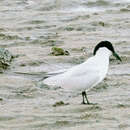pt-BR
nomes no trilho de navegação


The Australian tern or Australian gull-billed tern (Gelochelidon macrotarsa) is a tern in the family Laridae. The genus name is from Ancient Greek gelao, "to laugh", and khelidon, "swallow". It was previously considered conspecific with the gull-billed tern.
John Gould described Sterna macrotarsa from a specimen held at Kings College, London in 1837.[2]
This is a fairly large and powerful tern, similar in size and general appearance to a Sandwich tern, but the short thick gull-like bill, broad wings, long legs and robust body are distinctive. The summer adult has grey upperparts, white underparts, a black cap, strong black bill and black legs. The call is a characteristic ker-wik. It is 33–42 cm (13–17 in) in length and 76–91 cm (30–36 in) in wingspan.[3][4] Body mass ranges from 150–292 g (5.3–10.3 oz).[5]
In winter, the cap is lost, and there is a dark patch through the eye like a Forster's tern or a Mediterranean gull. Juvenile Australian terns have a fainter mask, but otherwise look much like winter adults.
It breeds in Australia and New Guinea.
This species breeds in colonies on lakes, marshes and coasts. It nests in a ground scrape and lays two to five eggs.
This is a somewhat atypical tern, in appearance like a Sterna tern, but with feeding habits more like the Chlidonias marsh terns, black tern and white-winged tern.
The Australian gull-billed tern does not normally plunge dive for fish like the other white terns, and has a broader diet than most other terns. It largely feeds on insects taken in flight, and also often hunts over wet fields and even in brushy areas, to take amphibians and small mammals.[3] It is also an opportunistic feeder, and has been observed to pick up and feed on dead dragonflies from the road.[6]
The Australian tern or Australian gull-billed tern (Gelochelidon macrotarsa) is a tern in the family Laridae. The genus name is from Ancient Greek gelao, "to laugh", and khelidon, "swallow". It was previously considered conspecific with the gull-billed tern.
La pagaza australiana (Gelochelidon macrotarsa)[2] es una especie de ave charadriiforme de la familia Laridae encontrada en Australia y Nueva Guinea. Anteriormente se consideraba una subespecie de la pagaza piconegra (Gelochelidon nilotica).
Mide entre 35 y 38 cm de longitud y entre 100 y 115 cm de envergadura.[3] La masa corporal varía de 150 a 292 gramos.[4] Es un ave marina bastante grande y potente, similar en tamaño y apariencia general al charrán patinegro, pero con el pico corto y grueso similar a las gaviotas, alas anchas, patas largas y cuerpo robusto. Durante el verano, los adultos tiene las partes superiores grises, partes inferiores blancas, una gorra negra y el pico y las patas negras. En invierno, pierde la gorra negra y tiene un parche oscuro a través de los ojos, similar al charrán de Forster o a la gaviota cabecinegra. Las aves juveniles tienen una máscara más tenue, pero por lo demás se parecen mucho a los adultos en invierno.
La pagaza australiana (Gelochelidon macrotarsa) es una especie de ave charadriiforme de la familia Laridae encontrada en Australia y Nueva Guinea. Anteriormente se consideraba una subespecie de la pagaza piconegra (Gelochelidon nilotica).